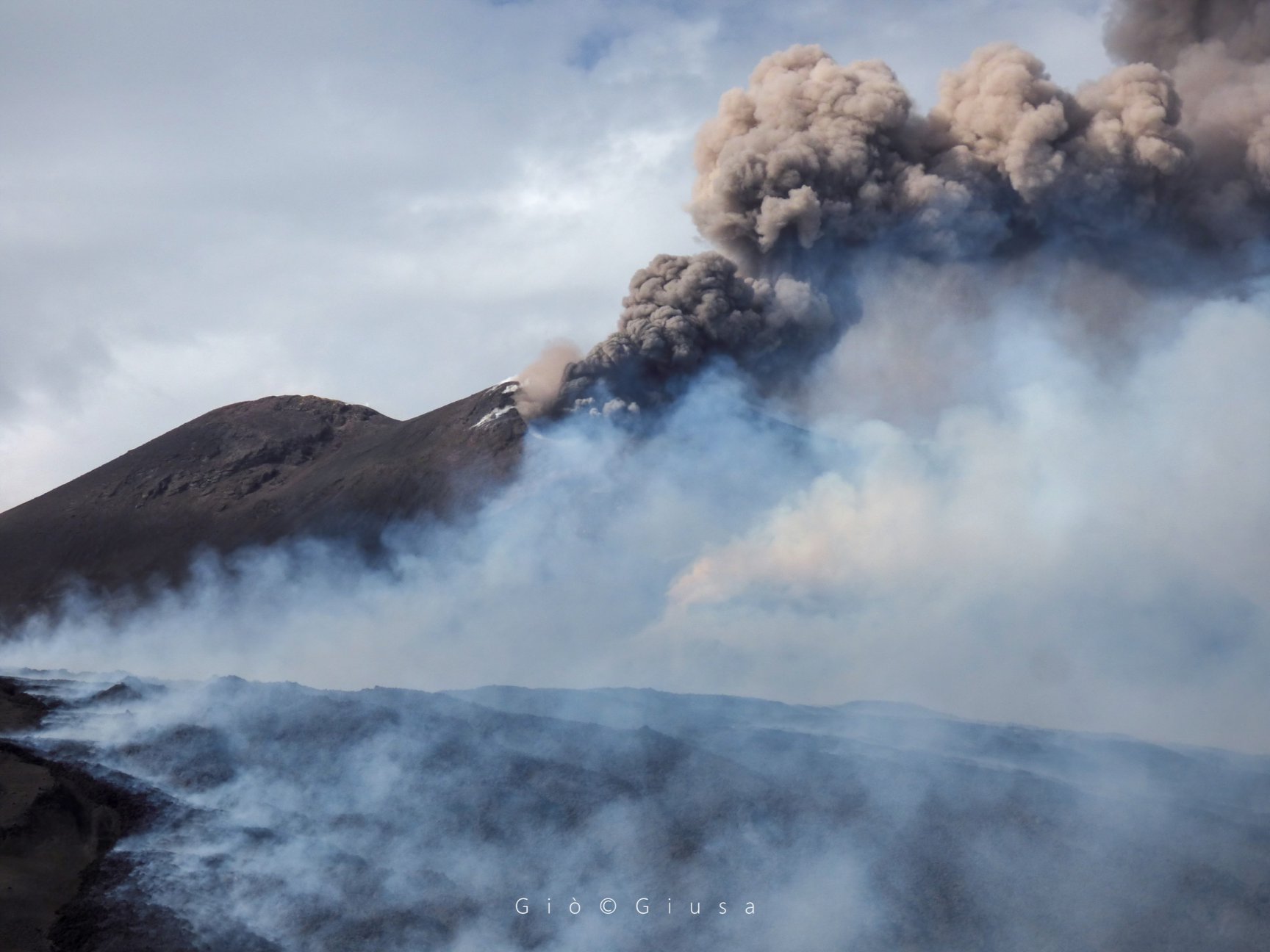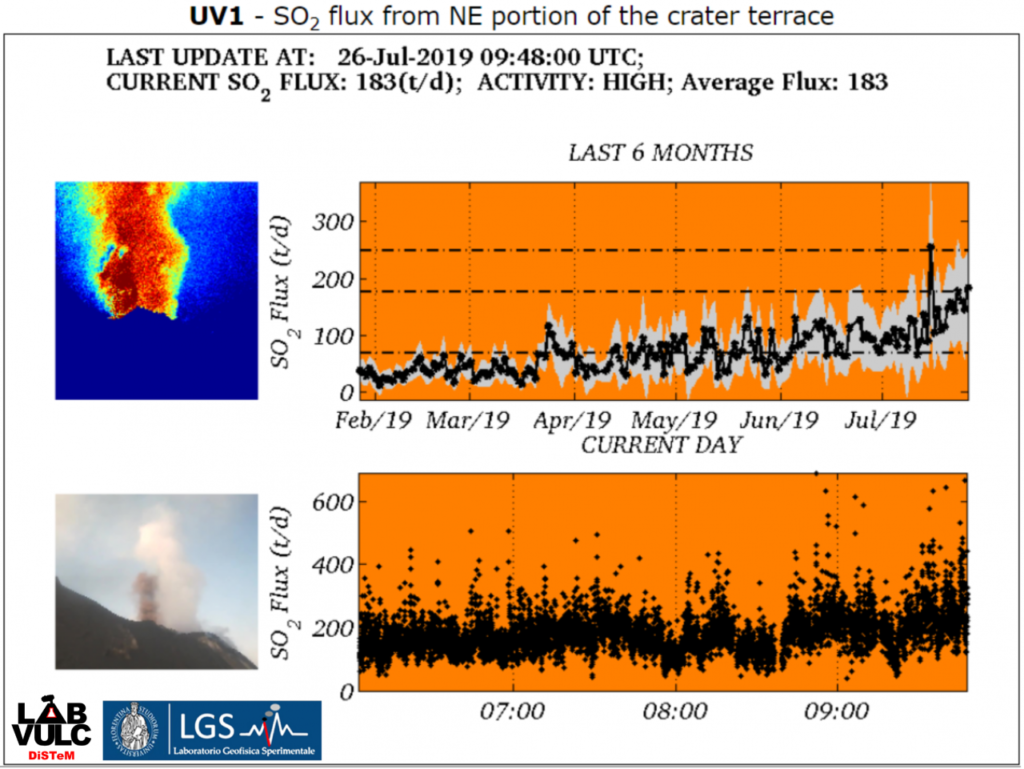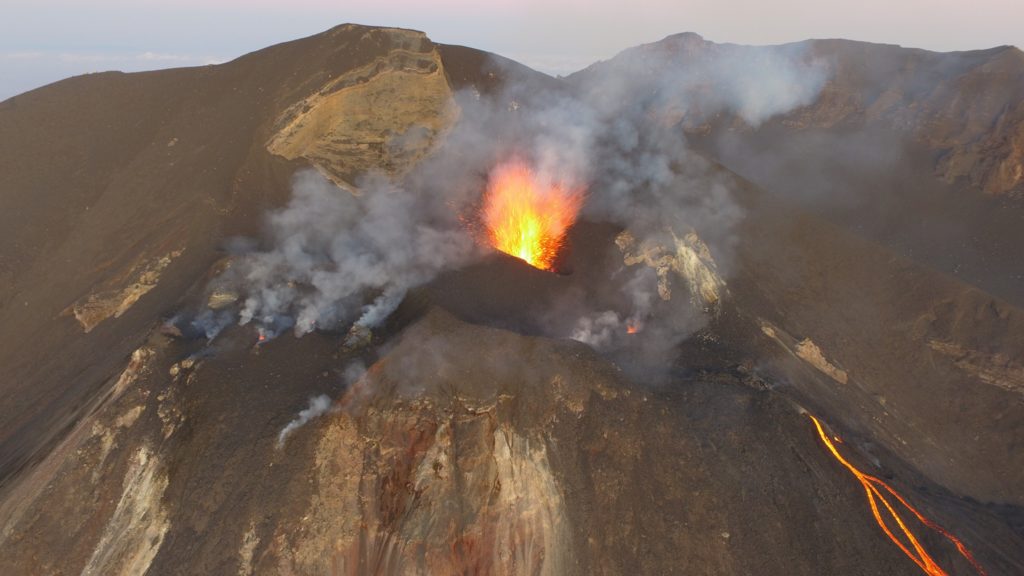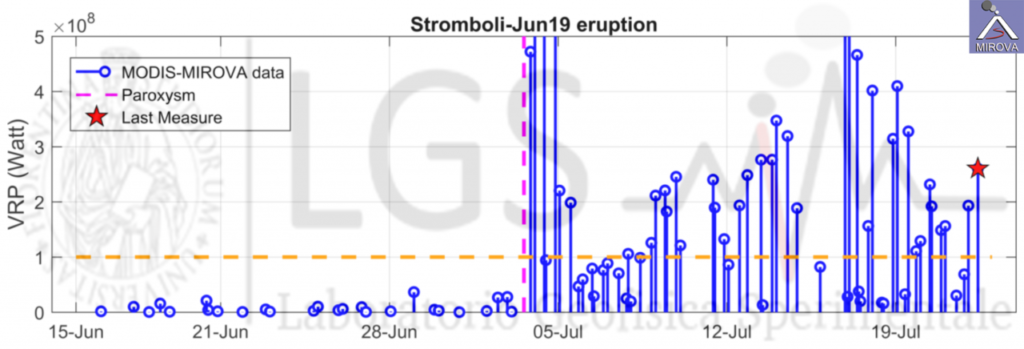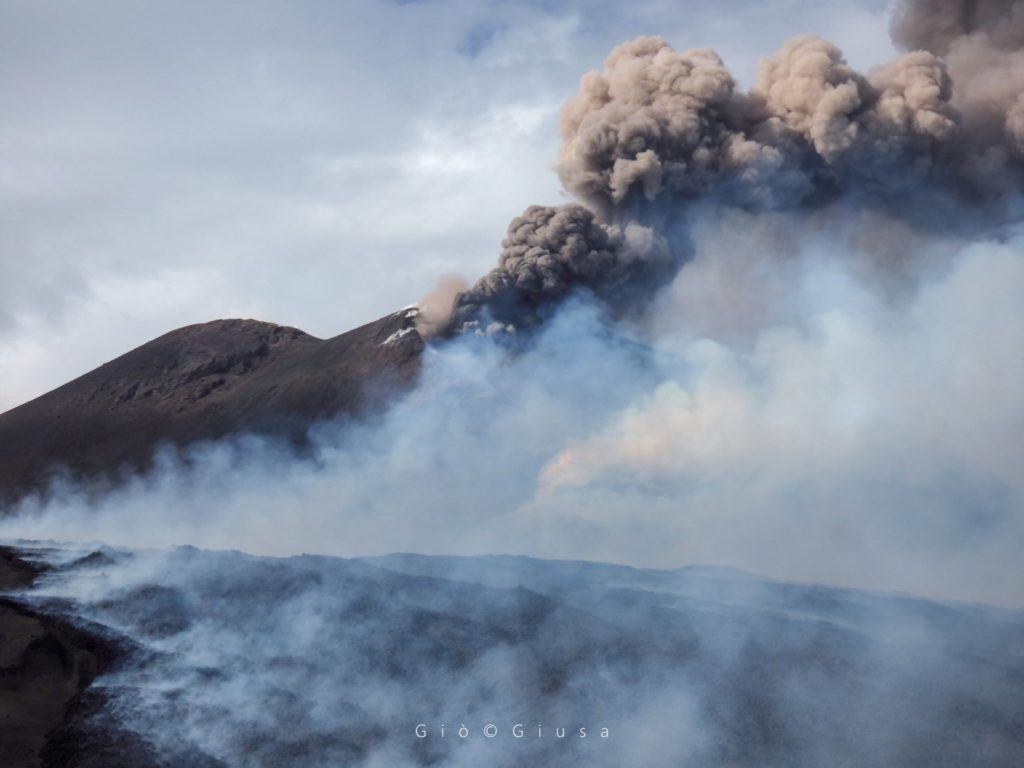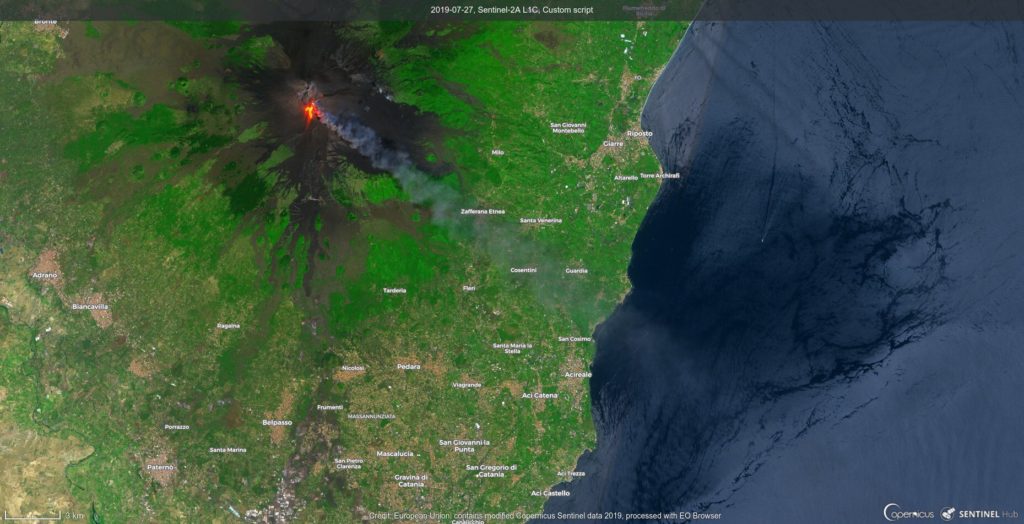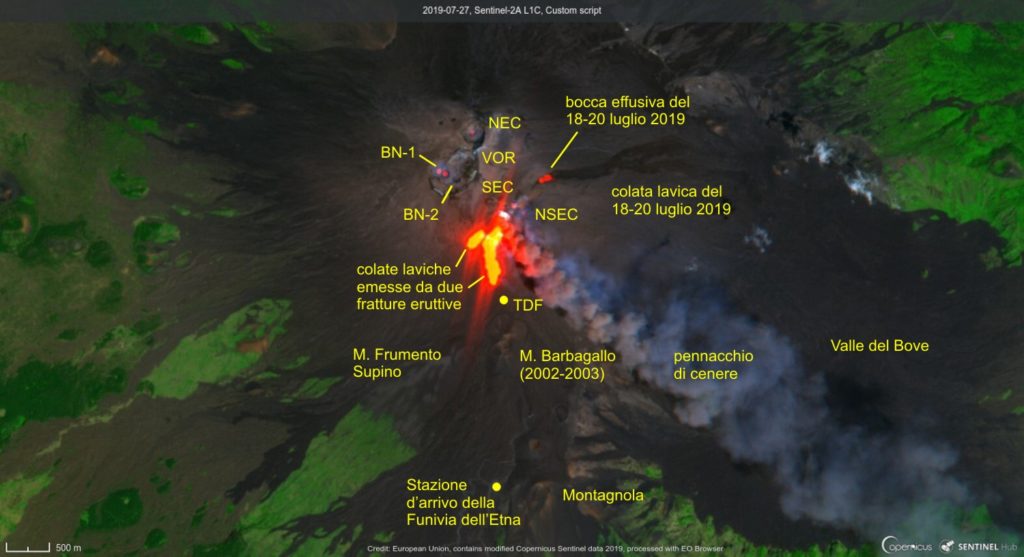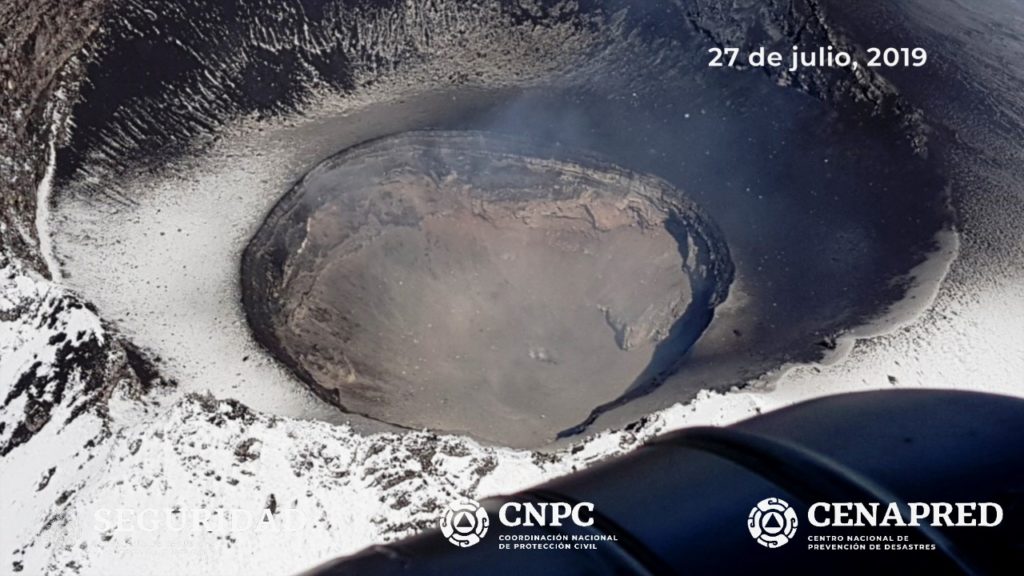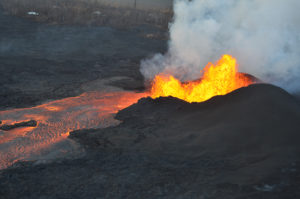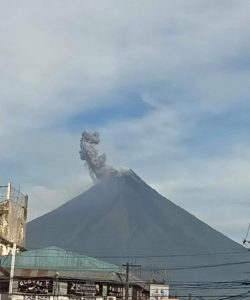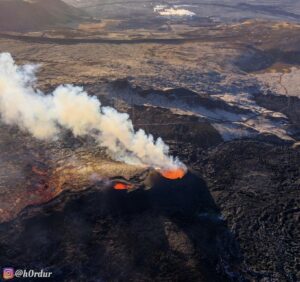July 29 , 2019.
Italy , Stromboli :
COMMUNIQUE N.16 ACTIVITY OF THE STROMBOLI VOLCANO, 1:30 pm (LOCAL TIME) on Friday, July 26, 2019.
From 07:00 UTC, the flow of SO2 continues to increase, which corresponds to the upward trend started in May 2019 (Figure 1) and which experienced a decisive acceleration following the paroxysmal explosion of July 3 . At 09:50 UTC, the flow of SO2 reached high values (183 tons / day) and at 10:50 UTC, it was 198 tons / day.
Figure 1. Time Series of SO2 Flows in the Last 6 Months (Top) and Today (Bottom)
At present, the explosive activity in the summit zone is characterized by violent and intense explosions, rich in ash and slag, emitted by a main cone formed in the sector SO, whose ash emissions reach a maximum height of about 400 m.
In NE crater area, the activity is characterized by frequent explosions with slag emissions from 3 main cones, aligned along the northern boundary of the upper Sciara del Fuoco.
Below the crater SO, in the North-West direction, is a second crater whose explosive activity is characterized by the bursting of gas bubbles of a few tens of meters, which form spherical emissions of very fluid magma. At the same time, the effusive vent located in the Southwest crater sector continues to feed many lava flows that develop in the upper part of the Sciara del Fuoco, thus forming a lava field below the sector. crater Southwest.
The thermal flux measured by satellite data (MODIS) confirms the way in which the activity observed and described above is favored by feed rates of 0.6 to 1.2 m3 / s (Figure 2).
Figure 2. Chronological series of thermal flows measured by the MODIS satellite as of June 15, 2019 (MIROVA – UniTO).
Source : lgs.geo.unifi.it.
Photo : Igor Fedele (Mediterranea Trekking of Messina)
Lire l’article : http://lgs.geo.unifi.it/index.php/blog/comunicato-stromboli-26-luglio-h1330
Italy / Sicily , Etna :
COMMUNICATION ON THE VOLCANIC ACTIVITY of July 28, 2019, 08:15:37 (UTC) – ETNA.
The National Institute of Geophysics and Volcanology, Osservatorio Etneo, reports that at 0340 GMT, signals from the seismic monitoring and monitoring network of the INGV show a significant decrease in the average amplitude of volcanic tremor.
https://www.facebook.com/francesco.tomarchio.7/videos/640902719735357/
At the same time, explosive activity at the New Southeast Crater (NSEC) has declined sharply. From the NSEC itself, the emission of a dense and light-colored plume remains, with no significant amount of ash. The effusive activity comes from the eruptive crack that opened yesterday morning along the south flank of the NSEC. From 7:46 UTC, the Northeast Crater occasionally emits small puffs of reddish brown ash that disperse rapidly into the atmosphere and fall near the crater.
At 7:45 UTC, the flow of SO2 detected by the FLAME network indicated an average value of about 15,000 t / d with maxima up to 20,000 t / d.
Regarding soil deformations, there have been no significant changes to Tilt and GPS stations since yesterday afternoon.
Two spectacular images captured at 10:00 h UTC (12:00 h local time) on 27 July 2019 by the Sentinel-2 satellite, showing the scene of the eruptive episode initiated little less than two hours earlier (at 08:09 UTC) at Etna’s New Southeast Crater.
In the second, close-up image, we have highlighted the summit craters (NEC = Northeast Crater; VOR = Voragine; BN-1 and BN-2 = western and eastern inner vents of the Bocca Nuova; SEC = Southeast Crater; NSEC = New Southeast Crater; note the thermal anomalies at the NEC and BN-1) and other sites often mentioned such as Montagnola, Monte Barbagallo, Monte Frumento Supino, Torre del Filosofo, and Valle del Bove.
Also shown are the lava flow of the previous (18-20 July 2019) eruptive episode, with a small, still active flow near the effusive vent, and the active lava flows emitted from two eruptive fissures at the southern and southwestern base of the NSEC, advancing southward. Images courtesy of European Union, Copernicus Sentinel data.
COMMUNIQUE ON THE VOLCANIC ACTIVITY OF ETNA, 28 July 2019, 19:45:46 h UTC (21:45 h local time).
The Istituto Nazionale di Geofisica e Vulcanologia, Osservatorio Etneo, reports that during a field survey carried out by INGV staff at the eruptive vents, it has been confirmed that explosive activity and lava emission have ceased. The lava field is thus not moving anymore and gradually cooling.
SO2 flux measured by the FLAME network has shown a gradual diminution in the degassing regime starting at 09:00 UTC, stabilizing at medium-high values around 6000 t/g.
The volcanic tremor amplitude has decreased to low values, though still slightly above those preceding the latest eruptive episode.
No significant ground deformation has been recorded by tilt and GPS stations since yesterday.
We share a video recorded the evening of July 27, 2019 on the activity of the new crater southeast of Etna. It was recorded in the area known as « Milia », upstream of the town of Ragalna, on the southwest side of Mount Etna. The video shows an explosive activity with ash emission, a strombolian activity without ash emission and a lava flow emission.
Source : INGV Vulcani.
Video : Frazncesco Tomarchio / Facebook. Boris Behncke .
Photo : Gio Giusa .
La Réunion , Piton de la Fournaise :
Activity Bulletin from Monday 29 July 2019 to 05h38 (Local time)
Since 05h13 local time, a seismic crisis is recorded on the instruments of the Volcanological Observatory of Piton de la Fournaise.
This seismic crisis is accompanied by rapid deformation. This indicates that the magma is leaving the magma reservoir and is spreading to the surface.
An eruption is likely in the near future in the next minutes or hours.
Further information will follow regarding the area impacted by this magmatic spread to the surface.
Under these conditions, the prefect decided to implement the alert phase 1 « probable eruption » of the specific device ORSEC * volcano as of today at 06:00.
Public access to the upper part of the Piton de la Fournaise enclosure, whether from the Pas de Bellecombe trail or from any other trail is prohibited. It is recalled that the landing of aircraft in the area of the volcano is regulated and subject to authorization from the Prefecture.
Source : OVPF.
Photo : Bernard Duyck.
Mexico , Popocatepetl :
July 28, 11:00 am (July 28, 16:00 GMT).
In the past 24 hours, 333 exhalations have been identified through the monitoring systems of the Popocatepetl volcano, accompanied by water vapor, gas and light amounts of ash. In addition, eight minor explosions were recorded yesterday (27/7) at 11:14 and 14:50 and today (28/07) at 00:09, 06:03, 07:59, 08:11, 08:50 and 08: 55 h. In addition, 211 minutes of tremor were recorded.
An incandescence was observed at night in the crater of the volcano. From today morning until the moment of this report, there is visibility towards the crater of the volcano, any event will be dispersed in a South-South-West direction.
Updated July 28th at 7:00 pm (July 29th at 00:00 GMT).
On July 27, with the support of the National Guard, an overflight of the crater of the Popocatépetl volcano was carried out. During this overview, the specialists of the National Center for Disaster Prevention (CENAPRED) of the National Coordination of Civil Protection and researchers of the Institute of Geophysics at UNAM were able to confirm that the dome number 83 of the volcano Popocatepetl had been destroyed by the recorded explosions and the ash emissions that had taken place before. In the same way, thermal images and photographs were obtained which made it possible to determine that the internal crater kept its same dimensions.
During this day, there were exhalations with a low ash content and heights ranging from 400 to 1,600 m. All expirations were dispersed in a southwestern direction.
CENAPRED urges NOT to approach the volcano and in particular the crater, because of the risk of falling ballistic fragments, and in case of heavy rains, to stay far from the bottom of the ravines because of the risk of mudslides and debris.
The warning light of Popocatépetl is in YELLOW PHASE 2.
Source : Cenapred .
Photos : Enricoguasch / Facebook , Cenapred.

